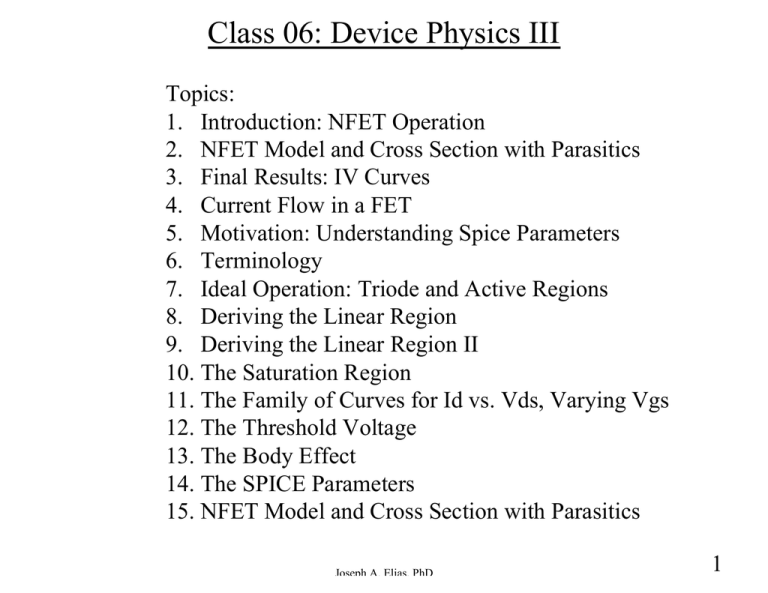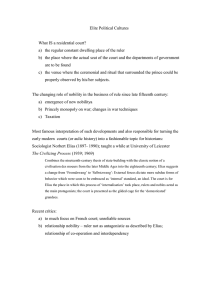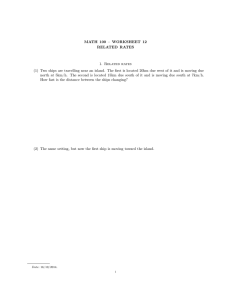Class 06: Device Physics III
advertisement

Class 06: Device Physics III Topics: 1. Introduction: NFET Operation 2. NFET Model and Cross Section with Parasitics 3. Final Results: IV Curves 4. Current Flow in a FET 5. Motivation: Understanding Spice Parameters 6. Terminology 7. Ideal Operation: Triode and Active Regions 8. Deriving the Linear Region 9. Deriving the Linear Region II 10. The Saturation Region 11. The Family of Curves for Id vs. Vds, Varying Vgs 12. The Threshold Voltage 13. The Body Effect 14. The SPICE Parameters 15. NFET Model and Cross Section with Parasitics Joseph A. Elias, PhD 1 Class 06: Device Physics III NFET Model and Cross Section with Parasitics (Martin p.101) •Goal is to understand the operation of an NFET shown in the model and cross section •Last lectures covered the pn junctions of the source and drain, operation of the channel •This lecture will cover the operation of the transistor as a whole •Question - what type of component is gmVgs? Joseph A. Elias, PhD 2 Class 06: Device Physics III Final Results: IV Curves (Martin p.97) •IV curves explain how the transistor performs when biased in different configurations •SPICE model explains these IV curves in terms of physics-based parameters •This lecture will concentrate on ideal behavior (triode/active); non-ideal(short channel) later •How many terminals in a NFET? Answer: 4 (S-G-D-Sub) •The IV curve above assumes source and substrate are shorted •The IV curve above assumes Id really means current from drain to source •Why is it called source and drain, and where is the current flowing to/from? Joseph A. Elias, PhD 3 Class 06: Device Physics III Current Flow in a FET (Martin p.87) source ground drain positive potential Electron flow Current flow source is a “source of” drain is “draining” majority carriers flow Current flow NFET electrons electrons source->drain Idrain->source Joseph A. Elias, PhD PFET holes holes source->drain Isource->drain 4 Class 06: Device Physics III Motivation: Understanding Spice Parameters (Martin p.121) •The ones not covered so far by lectures are: VTO, UO, LD, GAMMA Joseph A. Elias, PhD 5 Class 06: Device Physics III Terminology (Martin c.3) ID µn W L Cox Vgs Vtn Vds Vds-sat Veff Drain current, usually implying drain-to-source current (what else would it be?) Id -lin (linear) - current in the linear region (triode region) Id sat (saturation) - current in the saturation region (active region) Mobility of electrons Width of channel Length of channel Capacitance of channel oxide Gate to source potential Transistor threshold for n-type Drain to source potential Drain to source potential in the saturation regime Vgs - Vtn, which gives the voltage amount above or below threshold Joseph A. Elias, PhD 6 Class 06: Device Physics III Ideal Operation: Triode and Active Regions (Martin p.94) Three regions of operation: •Linear or Triode Region •Saturation or Active Region •Transition region Vds << Veff Vds > Veff Vdg ~ Vt or Vds ~ Veff Joseph A. Elias, PhD channel inverted channel pinched off beginning of pinch off 7 Class 06: Device Physics III Deriving the Linear Region (Martin c.3 Appendix) Similar to a resistor where the conductivity is and µn is the mobility of the carrier. n is density/volume This gives a current density of The total current flowing through a cube of dimensions W, L, H is The voltage drop along the direction of current flow is Combining the above gives where n is a function of x If one expresses n(x) as a function of charge density per unit square gives the relationship Since the voltage in the channel is not constant, one needs to relate the gate-source, threshold, and channel potentials to the charge in the channel through Q=CV. This formulates the vertical and horizontal relationships. Joseph A. Elias, PhD 8 Class 06: Device Physics III Deriving the Linear Region II (Martin c.3 Appendix) Substituting the charge density in the channel into the current equation gives Integrating the equation from 0 < dV < Vds and from 0 < dx < L gives Solving for Id gives the linear region: For very small Vds (i.e., Vds<<Veff): Joseph A. Elias, PhD 9 Class 06: Device Physics III The Saturation Region (Martin p.93) What causes the current to saturate? •As the drain voltage increases, the depletion region around the drain increases •As the depletion region increases, the number of free carriers at the drain decreases •The voltage at the drain is opposing the voltage from the gate, so the Vgd falls below Vtn •This is referred to as pinch-off, since the channel carrier density is pinched •One can then substitute Vds=Vgs-Vtn into the linear equation to obtain Joseph A. Elias, PhD 10 Class 06: Device Physics III The Family of Curves for Id vs. Vds, Varying Vgs (Martin p.97) As one increases the gate to source bias, the location of the pinch off increases since you now have more carriers in the channel. Short channel effects (to be discussed later): velocity saturation mobility degradation reduced output impedance hot-carrier effects Joseph A. Elias, PhD 11 Class 06: Device Physics III The Threshold Voltage (Martin c.3 Appendix) (1) (2) (3) (4) •The Vt implant is the “knob” used to control the behavior of the transistors •Everything else in the equation is fixed for a given technology Joseph A. Elias, PhD 12 Class 06: Device Physics III The Body Effect (Martin p.98, c.3 Appendix) As the bias on the substrate is made negative with respect to the source (Vsb:Vsource-to-substrate is positive), the p-type carriers are pulled away from the surface, increasing the depletion depth. This causes the channel to become more difficult to invert, shifting the Vt to a more positive value. The zero substrate bias is given as Vtn-0, and the body effect modifies the Vtn as: This modifies the IV curve as: Joseph A. Elias, PhD 13 Class 06: Device Physics III The SPICE Parameters (Martin p.121) We have now discussed all of the above, except: Ld is related to the pinch-off region, how far the drain is located underneath the gate MJ, MJSW which are the non-abrupt junction parameters for a pn junction Joseph A. Elias, PhD 14 Class 06: Device Physics III NFET Model and Cross Section with Parasitics (Martin p.101) Transconductance: Rds is the drain to source resistance Influence of body effect: Joseph A. Elias, PhD 15


